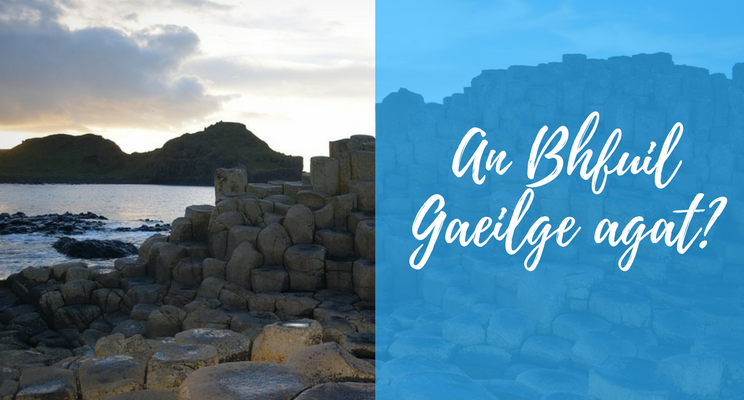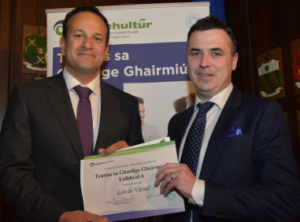Taking a look at the Irish language by busting myths and cool statistics

After leaving school and watching for the very last time, I never thought I’d be touching Irish ever again. Well, that was until I met a crazy translator who became my partner/business partner and forced me to learn it all over again. I took her up on the challenge. Looking back, I’m still not sure if it was to impress her or so that I didn’t look like an idiot for forgetting my native language. But a few years down the line I realised that it was more than helping the kids with their homework. Working in the language industry and being surrounded by so many passionate linguists, I realised just how embarrassing it is that here in Ireland, we don’t take our native language seriously.
Anyway, on to why we’re doing this article. We recently got back from a mammoth business trip tour, taking us all the way around Europe. During our stop to Bled, we met an absolutely lovely lady called Jarmila who works for the EU, managing all their translators. She got so excited when she heard I was Irish and we spent ages talking about the Irish language and how much trouble it’s giving the EU (we’ll touch on the details later). As everyone else seemed to enjoy listening to us debate about its future, I thought I’d sit down and write an article all about the Irish language and the revival that’s currently going on.
Common myths about the Irish language
First of all, let’s have a bit of fun. Here are some common myths about the Irish language, and how they’re not true at all. Then a bit later, we’ll go on to see what’s being done to sort this little issue all out.
Irish is pointless
When I was at school, Irish was seen as a dead language and a complete waste of time. Unless you were a language nerd (which took me until my late 20s to discover), you didn’t care. A current census from the Republic of Ireland and Northern Ireland shows that almost 2 million people have some knowledge of the Irish language, and 1.2 million people in the Republic are confident of their ability to speak the language. Did you know that most of the world’s languages have 7,000 or less speakers? Meaning that Irish has a lot more speakers than many other languages.
Gaelscoileanna (Irish speaking schools) are elitist
Over 50,000 children attend Irish speaking schools. They are mainly located in what are perceived as middle-class areas, which is why many people think they’re elitist. However, children from all walks of life attend them, and over half of the Gaelscoileanna in Dublin and Belfast are in working-class areas. Lately, some people have accused parents who send their children to Irish speaking schools of wanting their kids to go to Irish schools so that their children don’t have to go to school with children from other countries. In Ireland, we have the 6th highest proportion of foreign nationals, making up 11.3% of the population. So you might be able to understand where the link has come from. However, if you take a look at Colaiste Ghlor na Mara in Balbriggan, children from 15 different countries country go there.
Ireland would be poor if we spoke Irish
Believe it or not, many people feel that if we spoke Irish, we wouldn’t be able to trade with as many nations as we do now. And this is simply because of the language barrier. If you take a look at the GNI though, you can see that countries like Norway and Germany are even richer than Ireland, and English isn’t their first language.
Irish shouldn’t be an EU language
There are people out there who believe that Irish shouldn’t be an EU language. When a country joins the EU, they’re allowed to choose their official language. 3 EU countries have English as their official language – the UK, Ireland, and Malta. As English was already taken by the UK when both Ireland and Malta joined the EU, Ireland chose Irish as their language and Malta chose Maltese. The reason people think that Irish shouldn’t be an EU language is that they think it costs too much. But did you know that €1.1 billion is spent on translations a year, and that’s including all 24 languages, not just Irish?That works out at €2.20 per EU citizen a year, including all 24 languages. So Irish really isn’t all that expensive. Plus more Irish has been spoken in the European parliament than languages like Danish!
The Irish language is actually one of the most problematic for the EU. This is why I think we’re getting pretty good value for money. Irish translations cost double what any other language does. And they still manage to get it on budget! The reason Irish is so expensive is that there is a lack of Irish translators out there who can do the job. Many of them are now unwilling to move to become an in-house translator/interpreter. Interesting to think, though, that English won’t be an official EU language anymore once Brexit happens. I wonder if that will have an impact on the use of Irish or not.
The Irish language has been politicised
Many people think that because of the Troubles, Irish has become politicised. This isn’t really all that true, though, because there are even British army regiments that use Irish mottos. It’s now being used to bridge the gaps between people, to show that Irish isn’t one or the other. It belongs to us all and we can all learn it. (Though personally, I can never take my partner seriously when she gets mad and tries to swear at me in her very strange British/Czech Irish accent).
Irish language statistics
Ok, enough about the myths. What do people really think about the Irish language? I for one think it’s a shame I got so rusty after leaving school, which is why I am a bit harsh on the kids by making them take their Irish seriously.
By taking a look at the 2017 Kantar Millward Brown Survey, you can get some really interesting insights into the Irish language.
Let’s start with the positives. 78% of people in the Republic of Ireland and 57% of people from the North think that the Gaeltacht (Irish speaking areas) are of great importance. 81% of people in the Republic think that politicians should be fluent in Irish. Even 37% of people in the North think they should have the right to use Irish in courts (which is currently banned). This is interesting because only 33% of people in the North said they were against it. 66% of people in Northern Ireland think that Irish should become a core subject for GCSE. This really goes to show that attitudes in the North to the Irish language are changing. Maybe something to do with Brexit? Who knows, but 40% of people in Northern Ireland would like access to services in Irish (compared to 30% who wouldn’t), and 63% of people there think that every child deserves the right to an Irish-speaking education.
The Irish language revival
We’ve heard a lot about the revival effort. But it wasn’t until we sat down with Orlaith from Conradh na Gaeilge that we realised just how much is being done. Going to their office was like stepping into a Gaeltacht (Irish speaking town). All of a sudden no English was seen or heard anywhere (loved getting the one over on my partner again when the first thing she said to everyone was I like cake).
Their association, Conradh na Gaeilge is partly funded by Foras na Gaeilge. They focus on campaigns, lobbying, and promoting the Irish language. Plus they have 100 branches worldwide, including Hong Kong, LA, New York, and Berlin. They also organize things like Seachtain na Gaeilge (Irish speaking week) and peig.ie (Irish job website). There are also associations that support Irish speaking families raise their children in Irish (Glór na nGael) and ones that help schools with Irish-language education through Irish speaking areas and Irish speaking schools (Gaeloideachas). An tOireachtas organizes events that promote the language. The biggest of which, Oireachtas na Samha is a week-long event with approx 15,000 attending. Cumann na bhFiann provides services in Irish and Gael Linn deal with school students.
They’ve also worked hard giving Irish a social media presence by creating Irish-language filters on Snapchat (which have been used 18.6 million times). And they’ve translated Facebook and Twitter into Irish, too. Google is also available in Irish, and if you read their T&Cs you’ll see they make jokes about hurling rather than Ice Hockey. Irish is even one of the top 200 languages on the internet. So maybe Irish SEO is a trend we’re going to see in the future!
Going back to statistics, you can see that the Irish language revival is working. There has been a 5% rise in just two years in the number of people confident in their Irish abilities in the Republic of Ireland, with a 3% rise in the North. If this is only two years, we’re really looking forward to seeing how things change over the next 5 years. It’s odd that 36% of people in Ireland and 33% of people in the North think that Irish is portrayed in a negative light in the media. So it’s about time that organizations like Conradh na Gaeilge are here to help.
The Irish Taoiseach (prime minister), Leo Varadkar has also made headlines recently for getting his Irish certificate. He’d been taking lessons once a week to work on the fluency of his spoken Irish. So this has helped to give Irish a bit more publicity.
If you have any questions or would like to know about anything Irish related, get in touch. We’ll be happy to help.
Thanks once again to Condradh na Gaeilge for taking the time to have a chat with us, and for all the resources used in our research.


